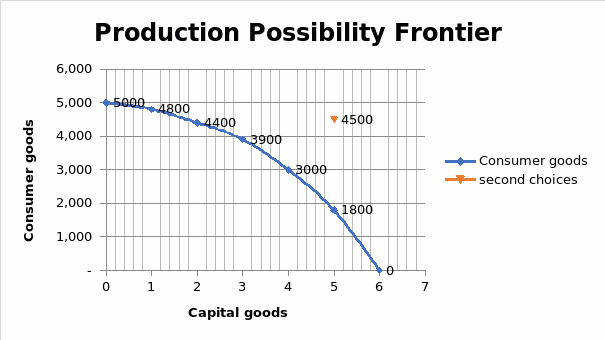Introduction
This paper intends to discuss opportunity cost. The first part covers the definition of opportunity cost and an example of a situation that gives rise to opportunity cost. This will be followed by an assessment of how time and information impact on opportunity cost. Thirdly, the link between scarcity, choice, and opportunity cost will be established. Furthermore, the paper will discuss the aspect of opportunity cost under the scenario of production possibility frontier. Finally, the essay will show the relationship between opportunity cost and comparative advantage.
Opportunity cost
In a study by McEachern (2011), opportunity cost of an item is the value that has been forgone for another alternative hence can be viewed as a lost opportunity. It is essential to understand that opportunity cost is subjective because the individual making the choice is the one who is able to choose the best available alternative. In many occasions, the person making the choice is not aware of the forgone alternative.
As an example, a student can forgo an evening with friends to study. Such a student will never know the exact value of what has been given up. However, the student expects returns from studying to be higher than returns from spending time chatting with friends.
In order to obtain the value of opportunity cost, time, and information is required. Economists are convinced that people are rational when choosing between alternatives. However, it does not mean that all alternatives are assessed thoroughly. A consumer would evaluate the different options only if the expected marginal benefit of collecting information concerning the options surpasses the expected marginal cost. Owing to the fact that studying the nature of alternatives takes a lot of time and is costly, some decisions are made based on scarce resources.
Scarcity, choice, and opportunity cost
There exists a link between scarcity, choice, and opportunity cost. First scarcity implies that a society does not have sufficient resources to meet all human needs thus the need to make choices. Therefore, a consumer is obliged to go for a particular choice instead of the other alternative. The link between scarcity, choice and opportunity cost can be illustrated using the following diagram.

Production possibility frontier
The aspect of scarcity can also be illustrated using production possibility frontier. The curve gives a combination of goods and services that a society can produce using limited resources. One of the assumptions behind production possibility frontier is fixed amount of resources. This means that quantities of resources remain unaltered. However, a firm can shift resources from producing one good instead of the other alternative.
A specific example is shifting labor from producing flour to producing capital goods. The impact is a reduction in output of flour while on the other hand, capital goods increases. Secondly, production possibility frontier assumes that resources are fully employed without any wastage. The final assumption of production possibility frontier is that technology is maintained at a constant level. Scarcity, therefore, allows an economy to produce on the frontier or inside the frontier as shown in the figure below. The output of 5 capital goods and 4500 consumer goods is not possible because of scarcity of sufficient resources.

The movement along production possibility curve is a demonstration of opportunity cost because one good is chosen over the other under a situation of scarce resources.
Calculation of opportunity cost
The example below illustrates the calculation of opportunity cost.
The table above shows that the opportunity cost of producing bacon is the opposite of the opportunity cost of producing wheat. It is apparent that 1 kg of wheat costs a rancher a quarter kg of bacon. Conversely, 1 kg of bacon costs the farmer 4 kg of wheat. At the same time, 1 kg of wheat costs the rancher a half kg of bacon. Similarly, 1 kg of bacon costs the rancher 2 kg of wheat.
A concept that emerges from the discussion of opportunity cost is comparative advantage. Where a producer gives up less of good X in order to produce good Y is said to have smaller opportunity cost of producing good Y. The producer, therefore, has a comparative advantage in producing good Y. Considering the example of a rancher and a farmer as tabulated above, the farmer is facing a lower opportunity cost of producing wheat.
While a kg of wheat costs the farmer a quarter kg of bacon, the cost to the rancher is a half of the bacon. The rancher, however, faces a lower opportunity cost of producing bacon compared with the farmer. In summary, the farmer has comparative advantage in producing wheat while the rancher has comparative advantage in producing bacon (Mankiw, 2011).
Conclusion
It is evident from the research that opportunity cost of an item is value that has been forgone for another alternative. Evidently, scarcity and choice leads to opportunity cost. Moreover, the paper confirmed that opportunity cost determines whether a firm has comparative advantage in producing one item as opposed to the other.
References
Mankiw, N. (2011). Principles of Economics. Mason: Southwestern Cengage Learning.
McEachern, W. A. (2011). ECON Macro 3. Mason: Southwestern Cengage Learning.